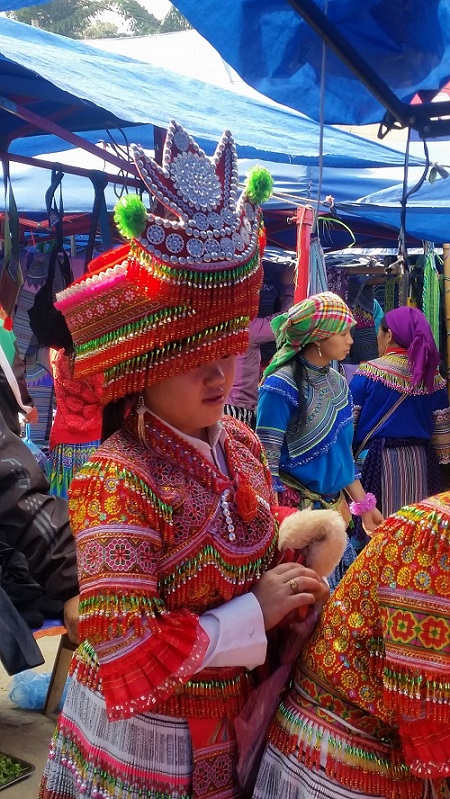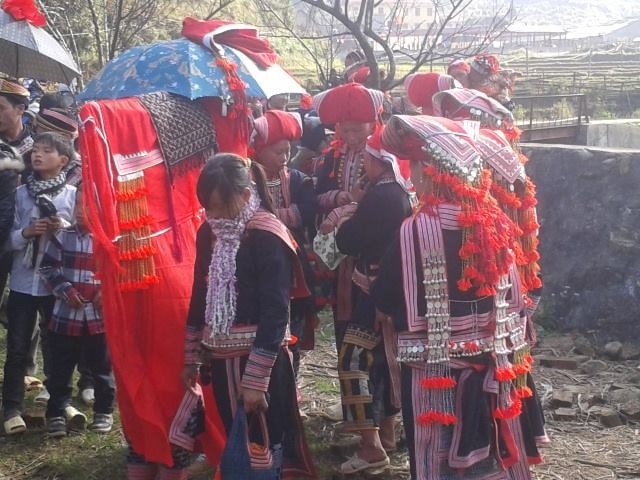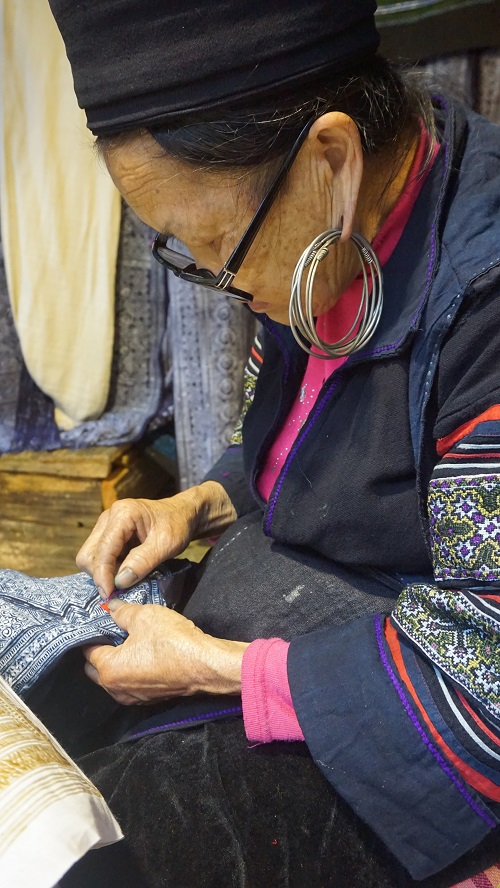- You are here:
- Home »
- Ethnic Groups »
- Ethnic groups in Lao Cai province

Ethnic groups in Lao Cai province
The population of the Lao Cai province is combination of ethnic groups. An incredible variety of peoples, some of them are unique in Vietnam and only found on a relatively small area.
In fact, visitors can meet 24 ethnic groups, each with its own language, culture and traditions.
This cultural wealth is explained by the diversity of landscapes and of land available for farming.
History also offers clues as to why the highlands in the Lào Cai province served as a refuge for certain ethnic groups during political unrest like the Taiping rebellion in 19th-century China.
Black Mong ethnic
Top seven biggest ethnic groups in the Lao Cai province occupy over 90% of the whole population.
The Kinh (Vietnamese) 35%, the Mong 22%, the Tay 14%, the Dao 13%, the Thai 9%, the Nung 4.5% and the Giay 4.3%. The other ethnic groups: the Phu La, San Chay, San Diu, Hoa, Ha Nhi, Bo Y, Khang, Lo Lo, Muong, Laos, Cong, Ngai, Kho Mu, La Chi, Lu, La Ha…
Sometimes represented only by a few villages and a few hundred individuals.
History and social life of the Mong , well known for a centuries in China by the name of Miao or called as Meo in Southeast Asia. population about three million, they are scattered over a vast territory stretching from South-West of China (2 million) to the North of Vietnam (600,000), Laos (about 250,000), Thailand (150,000) and Myanmar (about 30,000).
The main subgroups present in Vietnam are the White Mong, the Mong Leng, Mong Pua, Mong Shi or Sheu and the black Mong.
In Sa Pa, the black Mong are the most numerous, some Mong Sheu and Mong Pe, with their colourful skirts and come from Muong Khuong, Si Ma Cai, Bac Ha districts. Originally, the Mong ethnic in Chinese lived in the wide plains of the Yangtse river.
In 16th century, they started to migrate to the South-East under the demographic, territorial and political pressure of the Chinese.
During the first half of the 19th century, the Mong left the Chinese territory and settled in neighbouring countries.
At the time, the great Taiping rebellion (1850-1872) was disturbing all Southern of China (Guizhou, Yunnan and Sichuan provinces) causing long periods of famine that pushed numerous ethnic groups to go to the South.
The Mong entered the Indo-Chinese peninsula through North Vietnam, their presence near Lai Chau was reported in 1848.
These successive waves of migration were probably facilitated by the hmong tradition of shifting cultivation and their close contacts with the Chinese caravaneers who had been travelling for centuries through the mountains of Southern Asia.

Flower Mong ethnic
Today, the traditional agrarian economy is still based on family farms raising pigs, chickens, buffaloes and horses, on food crops (rice, corn, manioc) and cash crops (cardamom and vegetables).
The traditional social organisation of the Hmong is based on the clan. Each clan is made of lineages, all the members of which acknowledge a common founding male ancestor.
In the Hmong household, up to four different generations may be gathered under the same roof.
The household is the most important economic, political and ritual unit.
The villages perched on the mountain slopes house several clans. Easily recognisable by their costume, the Mong Leng – who do not call themselves are black Mongs – still wear hemp clothes dyed with natural (black-blue) indigo.
The women wear stiff indigo-blue turbans over their hair gathered into a bun. Nowadays, they hardly ever wear their batik or embroidered pleated skirts, replaced with short indigo pants.
Only the collar, sleeves and belt are embroidered with geometric patterns in silk.
The white Mong women from Bat Xat district wear long black pants, fairly short-waisted double-breasted jackets, and cover their hair with colourful head scarves.
The Mong Pua, Mong Pe and Mong Sheu women from Bac Ha district wear similar batik skirts with an embroidered band.
They are distinguished by the decorative patterns and shape of their aprons.

The wedding of red Dao ethnic
The Dao, known as the Man or Yao in South-West of China for centuries, also found few hundred thousand population in Laos, Thailand and Myanmar (formerly Burma).
The Dao-Mien settled in Vietnam two to three centuries ago, depending on the area.
One of the Dao’s specific cultural features is their traditional writing system using Chinese characters.
Preserved texts make it possible to trace their origins back to the provinces in the South of China.
Their taoist religion is also based on texts. For major taoist ceremonies, the ritual space must be surrounded with painted pictures of the divinities and celestial generals.
As a consequence, the art of painting on paper and canvas survives among the Dao.
Like the Mong, the Dao build terraced paddy-fields irrigated by a sophisticated system of canals around Sa Pa.
They also have a reputation for pig and horse breeding. The different Dao groups from Lao Cai province usually wear red headdresses or red pieces of clothing.

Phu La ethnic
The Dao (Ke Mien) from Ta Phin and Tavan villages (Sa Pa town) wear flat headdresses, totally red, with silver coins.
The headdresses of the Dao (Ke Mien) from Muong Hum commune (North of Sa Pa) are cone-shaped and made of red flowery material.
In Bac Ha district, Dao enhance their turbans with red and pink wool or silk threads.
The headdresses of the Dao (Iu Mien) from Van Ban district – South of Sa Pa – are decorated with red and yellow pompoms, and hang low down their backs.

Tay people in traditional costume
The Tay ethnic grow rice in paddy fields, preferably in the plains and in the valleys.
The villages consist of wooden or bamboo stilt houses and are often built in the immediate vicinity of a stream or a river.
The household is the basic economic unit and tends to be a nuclear family limited to close relatives.
The Tay, Giay, Nung and Thai women wear brightly-coloured jackets, – pink, green, or blue – double-breasted, often with contrasting braid at the collar.
The tartan headscarf covers their hair gathered into a bun. Traditionally, each group used to have their own style of bun, held up with long silver needles, but the custom is vanishing…
Photos and written by Thanh Tuan
About the Author Sapa Tourism Office
Popular posts


